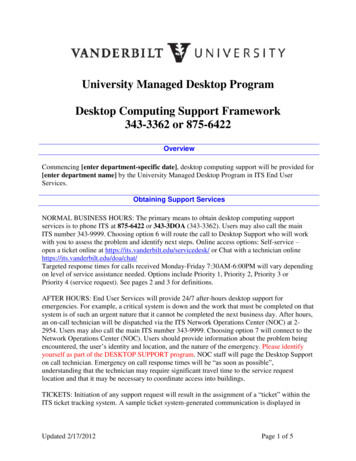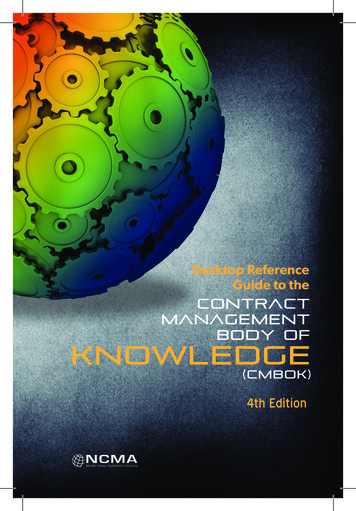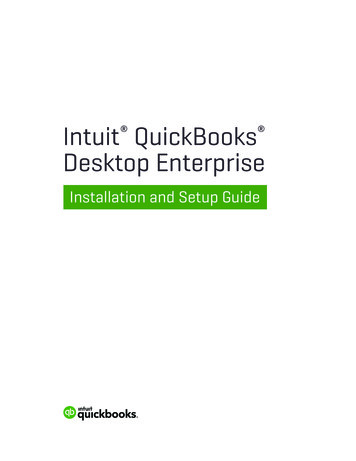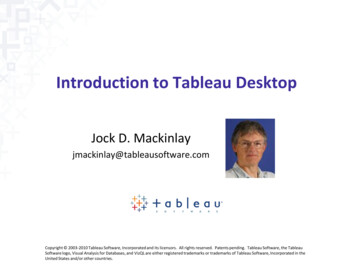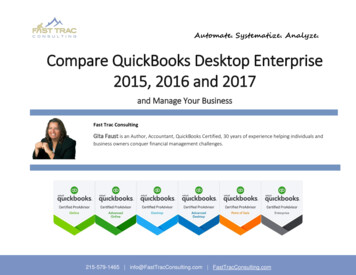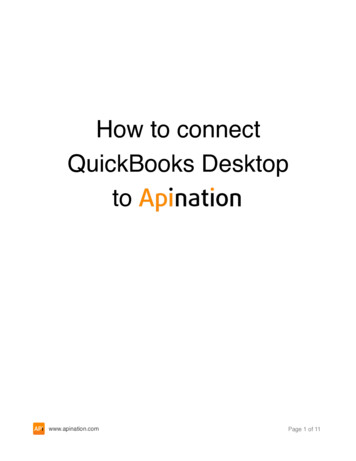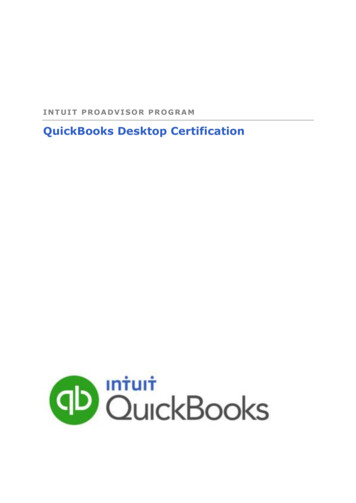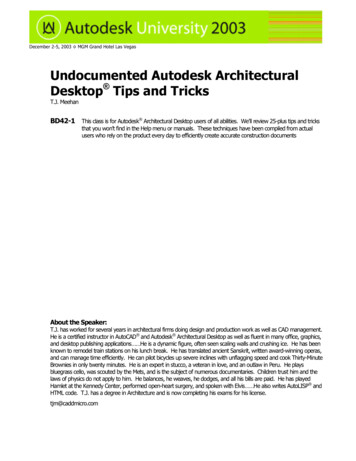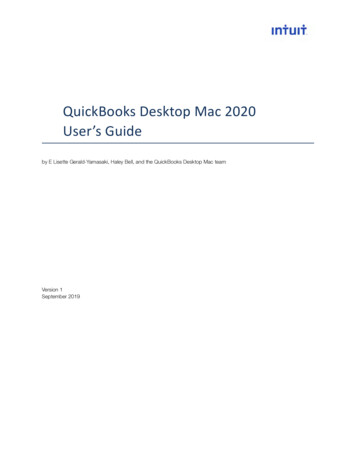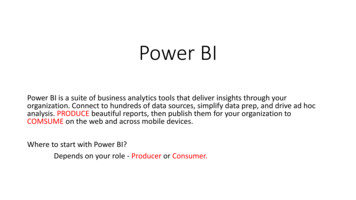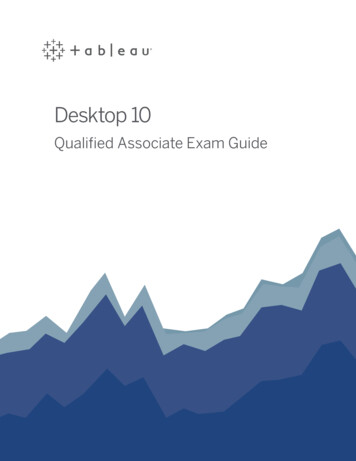
Transcription
Desktop 10Qualified Associate Exam Guide
Exam DetailsThis document provides information on the structure of the exam, along with the knowledge and skillsbeing measured. This document is not intended to build product knowledge.Awarded CredentialsUpon successful completion of this exam, you will be awarded the title of Tableau Desktop 10 QualifiedAssociate.Target AudienceThis exam is for those who have a comprehensive understanding of functionality in Tableau Desktop 10 andat least five months of applying this learning in the product.PrerequisitesThere are no prerequisites for this exam.System PreparationFor a successful exam experience, ensure your computer, network, and the physical environment areproperly configured. This includes running a system tech-check before the exam. Review our Required:Exam Setup document for complete details.Learning ResourcesThe best preparation is experience and time with the product. During the exam, you will have access topublic, online resources aside from sites or applications allowing for communication. We also encourage youto complete the Desktop I: Fundamentals and Desktop II: Intermediate classroom courses. Information onthese courses can be found here.Exam FormatTime Limit: 2 hours (Please plan for extra time for online exam setup)Passing Score: 75%Content Version: 10.0Number of Questions: 36Scoring: 100 points total; point value varies per question type with hands-on worth moreQuestion Format: Multiple choice, multiple response, true/false, hands-on (Tableau Desktop 10.0 will beprovided)Language(s) Offered: EnglishDelivery Platform: Virtual Machine containing Tableau Desktop 10.0For questions, email certification@tableau.com or visit tableau.com/certification.Desktop 10 Qualified Associate Exam Guide - Version 1.0October 2016
Skills MeasuredData Connections Understand how to connect to Tableau Server Understand Performance Optimization Parallel query Data engine vectorization Parallel aggregation External query caching Query fusion Understand how to use Automatic & Custom Split Understand how to join tables from single and multiple databases Understand how to use Data Preparation Blending Metadata Grid Pivot Union Data Interpreter Understand connection options Understand how to connect to different file types Understand data extract capabilities Understand Shadow extractsOrganizing & Simplifying Data Understand how to: Filter data Sort data Build groups Build hierarchies Build setsField & Chart Types Understand discrete v. continuous Understand measure names and measure values Understand generated fieldsDesktop 10 Qualified Associate Exam Guide - Version 1.0 Understand how and when to build: Histograms Heat maps Tree maps Bullet graphs Combined Axis Charts Dual Axis Charts Scatter Plots Data Highlighter Cross tabs Motion charts Bar in bar charts Box plots Gantt Bar Charts Paretos SparklinesUnderstand how to effectively use titles, captionsand tooltips Understand how to edit axes Understand mark labels and annotationsCalculations Understand how to: Manipulate string and date calculations Create quick table calculations Use LOD calculations; types of LODcalculations Use Ad-hoc calculations Work with aggregation options Build logic statements Build arithmetic calculations Build grand totals and sub-totalsOctober 2016
Skills MeasuredMapping Understand how to use: Pan & Zoom Filtering Map layering Custom territories Lasso & Radial selectionUnderstand how to modify locations withinTableau Understand how to import and manage customgeocoding Understand how to use a background image map Understand how to use Geographic searchAnalytics Understand how to use: Reference Lines Reference Bands Trend Lines Trend Model Forecasting Drag & Drop AnalyticsDesktop 10 Qualified Associate Exam Guide - Version 1.0 Box Plot Reference distributions Statistical summary card Instant AnalyticsDashboards Understand publishing & sharing options Understand how to build dashboards Understand dashboard actions Understand Device Designer Understand how to create a drill down report Understand how to utilize visual best practicesfor dashboard designTimelinessCompleting a task effectively and efficiently hasbecome a standard that organizations expect fromemployees. This exam is timed because we view timeas a critical competency needed to be successful.Requests for additional time will not be permitted.October 2016
Sample QuestionsThe questions below are examples intended to give you a sense of how questions will look on the exam. It isnot a learning resource for the Desktop product, nor does it provide the experience needed to successfullypass the exam. Sample questions are not indicative of exam difficulty. A solution section follows.You are encouraged to work through your own solutions first before looking at the solutions provided.1. To connect to multiple tables in a single data source at one time, what must be specified?a. A blendb. A calculationc. A joind. A hierarchy2. Tableau can create worksheet-specific filters.a. Trueb. False3. What does the box in a box plot represent?a. Maximum extent of the datab. The range of the middle half of the data pointsc. The median of the middle half of the data pointsd. The outliers of the dataThe following questions use the dataset Sample-Superstore Subset (Excel), which can be downloaded here. Ifyou are unable to download the file, try accessing it from another internet browser.4. What is the percent of total Sales for the ‘Home Office’ Customer Segment in July of 2012?a. 23.50%b. 23.97%c. 20.14%d. 32.56%5. Find the top 10 Product Names by Sales within each region. Which product is ranked #2 in both the Central& West regions in 2011?a. Riverside Palais Royal Lawyers Bookcaseb. Bush Mission Pointe Libraryc. Sharp AL-1530CS Digital Copierd. Global Troy Executive Leather Low Back TilterDesktop 10 Qualified Associate Exam Guide - Version 1.0October 2016
6. In the Technology Product Category, which unprofitable state is surrounded by only profitable states?a. Coloradob. Missouric. Wyomingd. Utah7. If 2013 Sales numbers were expected to increase by 50% in the following year, what would be the totalestimated sales for the Consumer Segment in 2014?a. 4,278,540b. 816,999c. 2,752,823d. 802,3658. In which Region do all Product Categories fall beneath the overall average profit?a. All Regionsb. Centralc. Eastd. Southe. West9. Which Product Sub-Category has a Shipping Cost to Sales ratio of above 3%?a. Tablesb. Chairs & Chairmatsc. Paperd. Binders and Binder Accessories10. Find the customer with the lowest overall profit. What is his/her profit ratio?a. 2.35%b. 1%c. -17.54%d. -771.39%11. Determine which State in the Central Region has the highest distribution of profits using interquartileranges.a. South Dakotab. North Dakotac. Minnesotad. IowaDesktop 10 Qualified Associate Exam Guide - Version 1.0October 2016
12. Look at the sum of profits for each Product Sub-Category. Which sub-category is 31,069 below theaverage profit across all categories?a. Appliancesb. Bookcasesc. Envelopesd. Paper13. What percent of total profits do the top 10 customer by Sales represent?a. 3.50%b. 5.03%c. 17.54%d. None of the Above14. What was the Moving Average of Sales in June of 2012, including six months prior and six months after?a. 101,752b. 180,036c. 188,552d. 286,17015. Create a histogram showing the number of Sales using Sales Bins of 1,000. Which bins have profit ratios(profit as a percentage of sales) of more than 25%? (Select all that apply)a. 1,000b. 3,000c. 7,000d. 8,000e. 10,000f. 11,000g. 18,000Desktop 10 Qualified Associate Exam Guide - Version 1.0October 2016
Solutions1. To connect to multiple tables in a single data source at one time, what must be specified?c. A join2. Tableau can create worksheet-specific filters.a. True3. What does the blox in a box plot represent?b. The range of the middle half of the data points4. What is the percent of total Sales for the ‘Home Office’ Customer Segment in July of 2012?b. 23.97%5. Find the top 10 Product Names by Sales within each region. Which product is ranked #2 in both the Central& West regions in 2011?c. Sharp AL-1530CS Digital Copier6. In the Technology Product Category, which unprofitable state is surrounded by only profitable states?a. Colorado7. If 2013 Sales numbers were expected to increase by 50% in the following year, what would be the totalestimated sales for the Consumer Segment in 2014?b. 816,9998. In which Region do all Product Categories fall beneath the overall average profit?d. South9. Which Product Sub-Category has a Shipping Cost to Sales ratio of above 3%?c. PaperDesktop 10 Qualified Associate Exam - Version 1.0October 2016
Additional GuidanceBelow there is additional guidance on a suggested method of finding the answer. You may find there areother ways determine the correct answer. The focus for this exam is the destination (i.e. accuracy), ratherthan the journey.10. Find the customer with the lowest overall profit. What is his/her profit ratio?The answer to this question can be found by looking at profits by customer and sort ascending by profit.Once you identify your customer contributing the least to your profits, add a profit ratio calculation(Sum([Profit])/Sum([Sales])) to the label or tooltip.Desktop 10 Qualified Associate Exam - Version 1.0October 2016
11. Determine which State in the Central Region has the highest distribution of profits using interquartileranges.The answer to this question can be found by showing Profit by State or Province, disaggregating yourmeasures, and showing distribution. You can use the available box plot option, or choose distribution –quartiles – 4, to show quartiles.Desktop 10 Qualified Associate Exam - Version 1.0October 2016
12. Look at the sum of profits for each Product Sub-Category. Which sub-category is 31,069 below theaverage profit across all categories?The answer to this question can be found by creating a table calculation looking at the sum of profitand subtracting from the window average (SUM([Profit]) –WINDOW AVG(SUM([Profit]))). Using thecalculation in your view and applying the label will reveal the difference from average for each subcategory.Desktop 10 Qualified Associate Exam - Version 1.0October 2016
Step-by-StepBelow are step-by-step solutions for a suggested method of finding the answer. You may find there areothers ways to determine the correct answer for each question.13. What percent of total profits do the top 10 customer by Sales represent?The answer to this question can be found by building a set for the top 10 Customers by Sales, then usingthat set in a view that uses the table calculation “percent of total.”a. Build a Set from Customer Name with the Top 1oby Sum of Sales.b. Include that Set in your view to display IN/OUT,along with Profit as the measure.Desktop 10 Qualified Associate Exam - Version 1.0October 2016
c. Convert Profit to a Table Calculation for Percentof Total.Final Response:Answer: b) 5.03%Desktop 10 Qualified Associate Exam - Version 1.0October 2016
14. What was the Moving Average of Sales in June of 2012, including six months prior and six months after?The answer to this question can be found by creating a view with Sales by continuous Month, then usinga table calculation to present a moving average.a. Build a view with continous Month and Sum ofSales.b. Right-click on Sum(Sales) and choose AddTable Calculation. Select a Moving Average withPrevious 6 Values and Next 6 Values, movingAcross the table.c. Once complete, hover over June 2012 and thetooltip will give the specific answer.Answer: c) 188,552Desktop 10 Qualified Associate Exam - Version 1.0October 2016
15. Create a histogram showing the number of Sales using Sales Bins of 1,000. Which bins have profit ratios(profit as a percentage of sales) of more than 25%? (Select all that apply)Creating this solution involves creating the bin of 1,000 each from Sales, including it in a view alongwith Sales shown as a Count, creating the Profit Margin calculated field, and filtering the view by ProfitMargin greater than 25%.a. Right-click on Sales in the Measures pane andchoose “Create” and “Bins”. Then change the binsize to 1000.Desktop 10 Qualified Associate Exam - Version 1.0September 2016
b. Once the bin is created, build a view with Sales(bin) on Columns and Sales on Rows. Thenchange Sales (on the Rows shelf) to the Countfunction.c. Create the Profit Margin calculated field andinclude it as a label. Use the formula SUM([Profit])/SUM([Sales]). Format the field as a percentage. Drag the Profit Margin to the shelf label.d. Filter the view to only show bins with a ProfitMargin of greater than 25%. Drag Profit Margin to filter. Choose “At Least” and the value “.25”.Final Answer: c) 7,000, d) 8,000, f) 11,000, g) 18,000Desktop 10 Qualified Associate Exam - Version 1.0October 2016
Tableau Understand how to import and manage custom geocoding Understand how to use a background image map Understand how to use Geographic search Analytics Understand how to use: Reference Lines Reference Bands Trend Lines Trend Model Forecasting Drag & Drop Analytics Box Plot Reference distributions
